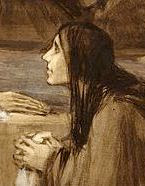Historical records reveal a queer side to Saint Francis of Assisi, one of the most beloved religious figures of all time. The 13th-century friar is celebrated for loving animals, hugging lepers, and praying for peace, but few know about his love for another man and his gender nonconformity. His feast day is today (Oct. 4).
Francis is “a uniquely gender-bending historic figure” according to Franciscan scholar Kevin Elphick He has spent years researching the queer side of Saint Francis, including travel to to the Italian town of Assisi. There he photographed artwork depicting the man he believes may have been the saint’s beloved soulmate: Brother Elias of Cortona.
Brother Elias (center) at the Baptismal font where St. Francis was christened in the Cathedral of San Rufino in Assisi, Italy. (Photo by Kevin Elphick)
When Francis (1181-1226) was a young man, he had an unnamed male companion whom he dearly loved -- and who was written out of history after the first biography. Other Franciscan friars referred to Francis as “Mother” during his lifetime. He encouraged his friars to be mothers to each other when in hermitage together, and used other gender-bending metaphors to describe the spiritual life. He experienced a vision of an all-female Trinity, who in turn saluted him as “Lady Poverty,” a title that he welcomed.
The earliest companion of Francis, a man whom Francis “loved more than any other because he was the same age” and because of “the great familiarity of their mutual affection” remains nameless. Elphick's research suggests that the unnamed soulmate of Saint Francis was Brother Elias of Cortona. Francis called Elias “Mother” and gave him a special blessing. Elias expressed much concern about Francis’ body and his health. Francis and Elias each describe the other in affectionate terms. However, very quickly after Francis died, Elias is written out of history and discredited. Elphick presents the scholarly evidence about their relationship in the detailed article at the Jesus in Love Blog: “Brother Elias: Soulmate to Saint Francis of Assisi?”
 | |
| Lady Jacoba also known as Brother Jacoba (See full image below) |
Early evidence of these and other ways that Francis crossed gender boundaries are gathered in the ground-breaking unpublished master’s thesis “Gender Liminality in the Franciscan Sources” by Elphick, who is both a Franciscan scholar and a supervisor on a suicide prevention hotline in New York. He wrote the thesis for a master’s degree in Franciscan studies from St. Bonaventure University in New York.
Francis’ love for another man is described in his earliest biography, The First Life of St Francis of Assisi
 by Thomas of Celano, a follower of Francis who knew him personally. The biography was completed by 1230, just four years after Francis died. Celano says that when Francis was in his 20s, before embracing a life of poverty, he dearly loved a special male friend:
by Thomas of Celano, a follower of Francis who knew him personally. The biography was completed by 1230, just four years after Francis died. Celano says that when Francis was in his 20s, before embracing a life of poverty, he dearly loved a special male friend:“Now there was a man in the city of Assisi whom Francis loved more than any other, and since they were of the same age and their constant association and ties of affection emboldened Francis to share his secret with him, he would often take this friend off to secluded spots where they could discuss private matters and tell him that he had chanced upon a great and precious treasure. His friend was delighted and, intrigued by what he had heard, he gladly accompanied Francis wherever he asked. There was a cave near Assisi where the two friends often went to talk about this treasure.”
In his thesis, Elphick points out, “Because homosexuality and ‘gay’ identities are modern constructs, it is impossible and inaccurate to attempt to read these modern categories into the personalities of historical figures.” Instead he uses the word “homoaffectional” to describe the relationship of Francis and his beloved companion.
“The relationship is inescapably homoaffectional, describing a shared intimacy between two Medieval men. That this first companion disappears from the later tradition is cause for suspicion and further inquiry.... The tone in Celano’s earliest account captures the flavor and intimacy of this relationship, perhaps too much so for an increasingly homophobic church and society.”
Francis and his beloved friend are seldom depicted by artists, but they are shown together in the rare and hard-to-find image above: “They shelter in a cave” (Se cobijan en una cueva) by Spanish painter José Benlliure y Gil. It is the 8th in his series of 74 images from the life of Saint Francis. The series was published by Franciscans in Valencia, Spain, in 1926 in a book to mark the 700th anniversary of the saint’s death. A commentary in Spanish about the picture is available online.
Elphick finds many more examples of what he calls “gender liminality” in historical documents on Francis. He defines liminality as “crossing the threshold of gender, either symbolically, or by actions within a person’s life that breach the social boundaries of gender.”
Francis was born to a wealthy Italian family in 1181 or 1182. As a young man he renounced his wealth, even stripping off his clothes, and devoted himself to a life of poverty in the service of Christ. He connected with nature, calling all animals “brother” and “sister” and celebrating them in his famous Canticle of the Sun.
 |
| “St. Francis ‘Neath the Bitter Tree” By William Hart McNichols© |
 by Kittredge Cherry.
by Kittredge Cherry.McNichols created the icon in his own style based on a 1668 painting by Spanish painter Bartolome Esteban Murillo, which was surely inspired by the more passionate 1620 version of fellow Spaniard Francisco Ribalta. In Ribalta’s work (pictured below), Christ responds to St. Francis’ ecstatic kiss by giving the saint his crown of thorns, the symbol of suffering that leads to divine union.
“Saint Francis Embracing Christ” by Francisco Ribalta (Wikimedia Commons)
 |
| “St. Francis and the Sultan” by Brother Robert Lentz, trinitstores.com |
In 1219 Francis went to Damietta, Egypt, with the European armies during the Fifth Crusade. He hoped to discuss religion peacefully with the Muslims. He tried to prevent Crusaders from attacking Muslims at the Battle of Damietta, but he failed. Francis was captured and taken to the sultan Malek al-Kamil. At first they tried to convert each other, but each man soon recognized that the other already knew and loved God. They remained together, discussing spirituality, for about three weeks between Sept. 1 and Sept. 26. Robert Lentz celebrates their meeting as a model of interfaith dialogue in the icon “St. Francis and the Sultan,” pictured here.
 |
| “St Francis of Assisi Receiving the Stigmata” by Kevin Raye Larson © 1991 |
Along with the stigmata came other health problems. When Francis sensed death approaching, he called for Jacoba de Settesoli, a Roman noblewoman devoted to him and his teachings. Francis stayed in her house when in Rome. Celano’s 13th-century account in the “Treatise on the Miracles of Blessed Francis” reports that Francis greeted the news of her arrival at the male-only cloister with a decidedly queer statement that breaks gender rules::
“Blessed be God, who has guided the Lady Jacoba, our brother, to us. Open the door and bring her in, for our Brother Jacoba does not have to observe the decree against women.”
The widow called “Brother Jacoba” by Francis kneels near the dying Francis of Assisi in “48. Jacoba of Settesoli is associated with the mourning” (Jacoba de Settesoli se asocia al duelo) by José Benlliure y Gil, 1926 (Wikimedia Commons)
Francis died a few days later on Oct. 3, 1226. Two years after Francis’ death, Pope Gregory IX declared him a saint and commissioned Celano’s biography, the one that includes the love between Francis and his male companion.
Elphick adds an intriguing footnote about how the queer side of Francis has manifested outside official Christianity. Francis is venerated in the Yoruba religion of Africa as Orunmila, the orisha of wisdom, patron of animals and a transgendered deity who engages in same-sex eroticism.
At the end of his thesis, Elphick concludes that breaking gender rules is an extraordinary God-given power or “charism” that Franciscans offer to the church and the world.
“What are the lives of figures like Mother Francis, Brother Jacoba and Mother Juana de la Cruz revealing to us in our own day? I think that the Franciscan charism of gender liminality has much to teach our Church and fellow community of humans in our day. In a church divided over issues of ordination of women, inclusive language, and sexual orientation, I believe that the Franciscan tradition has important figures to hold up and from whom to learn. For issues which we have not even yet begun to explore theologically in authentic ways, issues such as hermaphroditism, transsexuality, genderedness and sexual orientation, I believe the Franciscan voice can be prophetic.”
“Saint Francis in Ecstasy” by Caravaggio (Wikimedia Commons)
___Related links:
"The Message of St. Francis" by Kevin C. A. Elphick (The Empty Closet)
To read this post in Spanish / en español, go to Santos Queer:
San Francisco de Asís: La evidencia histórica revela su lado gay
Animal blessing events are happening all over the world this month for the Feast of St. Francis, the patron saint of animals. Click here for animal blessing prayer by Kittredge Cherry.
___
Top image credit: Francis of Assisi and the man he loved in “They Shelter in a Cave” by José ___Benlliure y Gil, 1926 (Wikimedia Commons)
____
This profile is part of the GLBT Saints series by Kittredge Cherry at the Jesus in Love Blog. Saints, martyrs, mystics, prophets, witnesses, heroes, holy people, deities and religious figures of special interest to lesbian, gay, bisexual and transgender (LGBT) and queer people and our allies are covered on appropriate dates throughout the year.
Copyright © Kittredge Cherry. All rights reserved.
http://www.jesusinlove.blogspot.com/
Jesus in Love Blog on LGBT spirituality and the arts
Innovative icons of St. Francis and many others are available on cards, plaques, T-shirts, mugs, candles, mugs, and more at Trinity Stores






